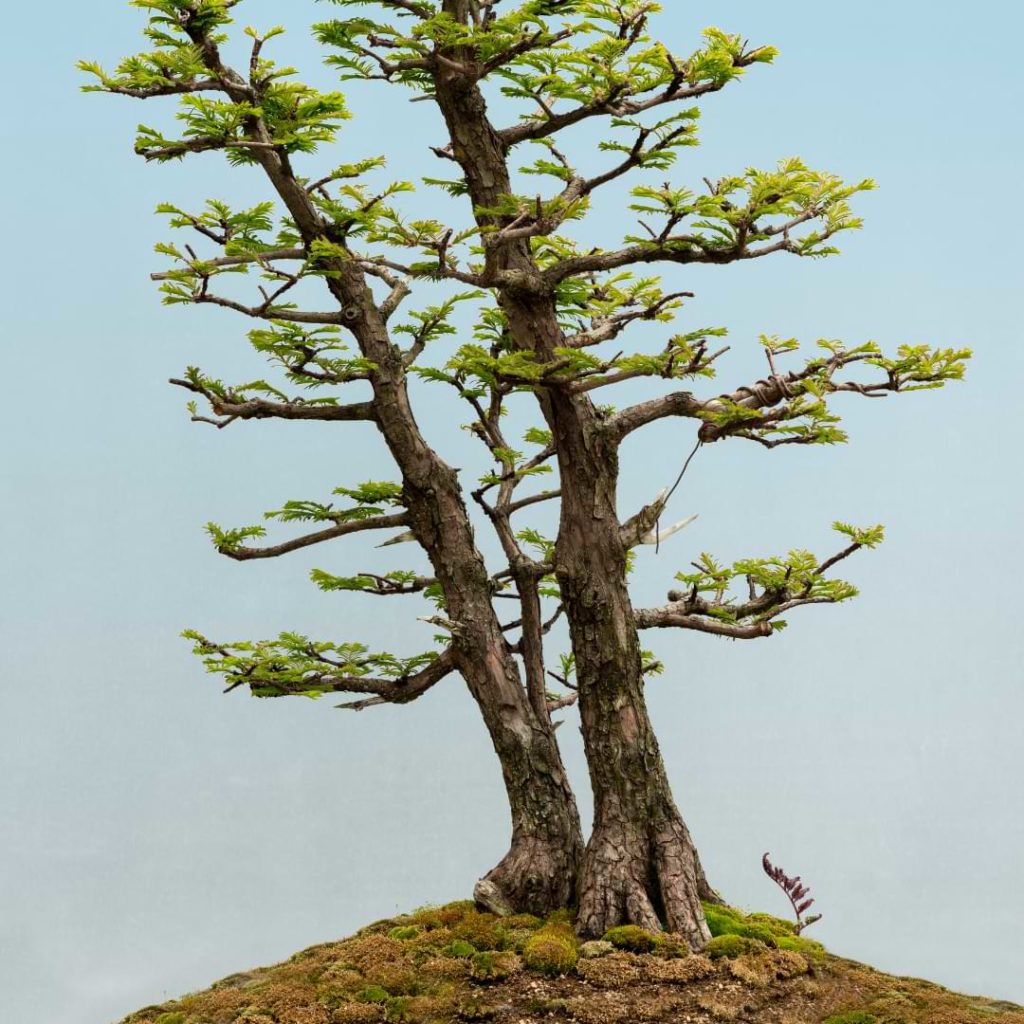Giant redwoods evolved among the dinosaurs, and some individual trees are among the oldest life forms on the planet. So it may come as no surprise that these prehistoric plants are prized specimens in the ancient art of bonsai.
But redwood trees aren’t just the oldest—they’re also the tallest and largest trees on earth. That must mean they’re pretty challenging to grow pint-sized, right?
Not exactly.
General redwood bonsai care can be more intensive than other starter species; they’re fast-growing, water-intensive, and sun-hungry. But since they require minimal shaping and wiring, their technical care can be less intimidating for a new grower.
If you’re just getting started, or if you’re simply redwood-curious, this beginner’s guide will teach you everything you need to know for happy growing.
Types of Redwood Bonsai
The first step to mastering redwood bonsai care is to understand the different species of redwood tree: Dawn (Metasequoia glyptostroboides); Coast (Sequoia sempervirens); and Giant Sequoia (Sequoiadendron giganteum). These towering trees are all close relatives, but some are better suited for bonsai than others.
1. Dawn Redwood Bonsai Tree
Once thought to be extinct, Dawn redwoods were rediscovered in China in the 1940s. Fast-growing, durable, and visually appealing, Dawn redwoods are one of the most prized varieties of bonsai tree. An anomaly in the family, these deciduous trees provide a delightful display of changing colors at the end of each growing season, and shed their lacy needles during the colder months.
Growing a Dawn Redwood Bonsai Forest
Slender Dawn redwoods are a favorite for creating bonsai forests, which are groupings of the same species planted in a single pot. To create a tiny thicket of your own:
- Start redwood saplings in separate containers until they’re well-rooted.
- Trim each individual tree into the desired appearance before grouping.
- Place in a shallow container closely grouped together (root balls should touch).
- Cover root systems with potting mix and water generously to set the soil and jump-start the trees’ recovery process.
Frame-by-Frame: Check out this bonsai techniques video by Horsham Bonsai for a visual guide.
2. Coast Redwood Bonsai Tree / California Redwood Bonsai Tree
Coast redwoods are the tallest trees on earth and can grow upwards of 370 feet. So, it’s no surprise harnessing these towering titans in pygmy form is a crown achievement for the bonsai enthusiast.
Their slender, upright trunks and pliable bark make for excellent bonsai specimens. But they’ll keep you on your toes! Coast redwoods are destined for the sky, and will quickly outpace the bonsai grower if not carefully maintained. During the growing season, check your tree daily for new buds, runaway roots, or wire damage.
3. Giant Sequoia Bonsai Tree
The world’s largest tree, California’s famous giant sequoias can grow to a mammoth 30 feet in diameter. But although they are perhaps the most well-known species in the redwood family, giant sequoias are infrequently used as bonsai specimens. That’s because their brittle bark is extremely strong and difficult to train into the desired shape.
While gorgeous giant sequoia bonsai do exist, the remainder of this article will focus on Coast and Dawn redwood bonsai care.
Getting Started: Redwood Bonsai Care
As with nurturing any living thing, redwood bonsai care comes down to providing the right environment and elements for growth. The three key techniques you’ll need to master are placement, watering, and fertilization. Let’s take a closer look at some beginner FAQs.
1. Placement: Can Dawn Redwood Grow Indoors?
Both Dawn and Coast redwood bonsai will be happiest growing outdoors. However, redwood bonsai trees are surprisingly tolerant of indoor growing in the right conditions. Whether backyard or bedroom window, proper placement comes down to sunlight and humidity.
- Sunlight: Redwood bonsai require 8+ hours of sunlight per day during the growing season. However, these Pacific Coast natives can’t tolerate extreme heat, and must be protected from direct sunlight during the hottest months of the year. If growing indoors, place in a south-facing window and supplement with grow lights if necessary.
- High humidity: Outdoor conditions generally provide adequate humidity for your tree. Indoors, the moisture-loving redwood tree may struggle to adapt to a dryer environment. Place your tree on a humidity tray filled with pebbles and water to simulate the foggy, humid conditions in which it evolved.
Final Call: A redwood bonsai will benefit from fresh air, direct sunlight, and build resilience outdoors, making this the optimal placement. While a Dawn redwood bonsai can survive indoors, it’s up to you to emulate the conditions it would receive out in the elements.
2. Hydration: How Often Should I Water Dawn Redwood?
While some varieties like to dry out between baths, redwood bonsais prefer to stay moist. Both Dawn and Coast redwoods will need to be planted in a well-draining soil and watered frequently during the growing months. Be prepared to water every other day, or even daily if your tree receives full sun.
Rather than following a schedule, monitor moisture levels in your individual tree using your finger or a soil meter. Water once the top layer of soil becomes dry to the touch, and never let the root ball dry out.
Bonsai Beware: Even dormant trees consume water, however slowly. Check your tree weekly during the winter months to determine if it’s time for a dip (and don’t let moist soil freeze!).
Still learning? Our guide to bonsai tree watering has got you covered.
3. Nutrition: Fertilizing Redwood Bonsai Trees
Redwood bonsai trees respond well to a balanced organic fertilizer applied once every two weeks throughout the growing season. Some experts recommend using a high-nitrogen fertilizer in the spring to kick things off. For deciduous and coniferous redwood bonsai alike, pause your fertilization schedule during the dormant months.
We Recommend: Using a gentle liquid bonsai fertilizer to provide a steady stream of essential nutrients to fast-growing, hungry redwoods. (Whichever type of fertilizer you select, follow the directions on the side of the container.)
How to Bonsai a Redwood Tree
The redwood bonsai care basics outlined above will ensure a healthy tree—but how do you achieve the bonsai effect with nature’s most giant creations? Look no further than pruning, shaping, and below-ground maintenance.
1. Maintenance: How Do You Prune a Redwood Bonsai Tree?
Since both Dawn and Coast redwood trees grow tall and thin, formal upright is by far the most common bonsai style. Rather than bending and shaping, you’ll simply pinch back new buds and trim the canopy to prevent upward growth. This allows your tree to grow into its natural shape—only smaller! Trim twigs and prune buds and suckers immediately during the growing season to reign in this fast-growing species.
Bonsai Beware: Defoliation techniques are often used to encourage bonsai trees to grow smaller foliage. While you may defoliate the deciduous Dawn redwood, do not defoliate Coast redwood bonsai (or any type of coniferous tree, their needles won’t grow back!).
2. Shaping: How Do You Wire a Redwood Bonsai Tree?
To allow your redwood bonsai to grow into its natural (informal upright) shape, it’s best to limit the amount of wiring and training you perform. If major branches must be redirected or straightened out, gently wire into a downward position.
Wire the deciduous Dawn redwood in the early spring before new buds appear. But watch your tree closely, its fast-growing limbs can easily be marred or damaged if the wire is left on too long. For the coniferous Coast redwood, it’s better to wait until late fall, when sap flow has slowed and the tree is more malleable.
3. Below Ground: Redwood Bonsai Soil & Root Maintenance
Like all bonsai, constraining the root system is the key to growing a pint-sized redwood. Your tree’s root ball should fill its entire pot, with no more than three-quarters of an inch between root tip and container wall. Expect to repot your mature tree every two to three years, once the roots start to crawl over the top of the soil.
Perform the following during the repotting process:
- Remove old, depleted soil gently with your fingers or a root rake.
- Inspect roots for decay or disease and remove any brown or rotting sections.
- Trim the roots to restrict upward growing power. (Do not remove more than ¼ of the total root system.)
- Transfer to a larger pot if your tree will not fit without trimming more root ball than recommended.
- Refill the pot with fresh, nutrient-rich soil and water immediately to set.
Learn more: Master bonsai repotting and root maintenance with this quick and easy beginner’s guide.
Have more questions about redwood bonsai tree care? Keep the conversation going in our Facebook group.
Bonsai With Us!
The Bonsai Resource Center is here to help you learn how to make a bonsai tree and provide you with the tools you need to keep your tree healthy and strong. Explore our other articles, visit our online shop, and connect with other bonsai lovers in our Facebook group to learn everything you need to know about this rewarding hobby!
More Bonsai Tree Resources
How to Care for a Bonsai Ficus Tree
How to Care for Your Weeping Willow Bonsai



